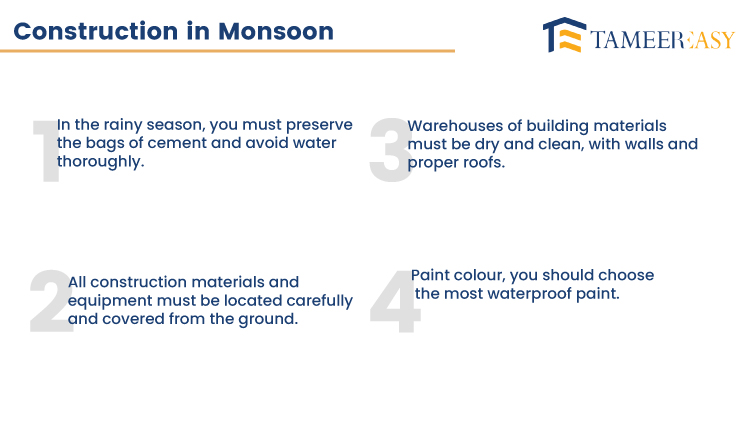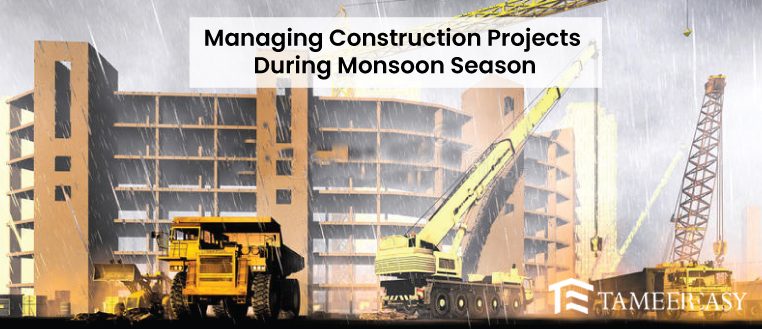Managing construction during the rainy season is a key difficulty frequently faced by building projects. Rainstorms that are expected to be heavy might cause delays, safety issues, and even structural damage. Construction businesses may overcome these obstacles and guarantee project success by implementing sensible strategies and best practices.
This post will look at some of the most important tactics for overseeing building projects during the monsoon: planning and preparation, site management, material concerns, safety procedures, and communication procedures.
Best Strategies and Practices to Follow During Monsoon Construction
1). Planning and Preparation
Effective planning and preparation are crucial for construction projects to be effectively managed during the monsoon season. It starts with a thorough investigation of the weather and an awareness of the region’s historical rainfall patterns. Construction businesses can designate particular periods for tasks less prone to rain disruptions by including this information in the project schedule.
Especially the choice of the venue is very important. Rainfall’s effects on the construction site can be reduced by locating places with good natural drainage and ensuring appropriate grading and slope. Furthermore, maintaining project momentum will be aided by creating thorough contingency plans that specify alternative work schedules and rescheduling techniques in the event of excessive rain.
2). Site Management
During the rainy season, careful site management is essential to reduce delays and preserve productivity. Rainwater harvesting can be diverted from important places by implementing efficient site drainage systems, including correctly installing channels, trenches, and drains. Regular inspection and maintenance are required to ensure these systems’ functionality.
Accordingly, open excavations should be covered, and sensitive materials and equipment should be shielded from the elements using tarpaulins or temporary shelters. This will help to avoid delays and water damage. It is essential to create adequate temporary access roads or walkways with good grip so that people may move around the site even when it’s raining.

3). Material Considerations
Construction during the monsoon season requires careful material selection. By choosing water-resistant materials, you can lessen the harm that persistent moisture exposure causes. For surfaces prone to water infiltration, this includes the application of waterproofing membranes, sealants, and coatings.
Additionally, damaged materials must be replaced regularly to maintain the project’s quality and structural integrity. Construction supplies must be stored and protected properly. Stockpiles should be adequately covered or kept in weatherproof containers to avoid water damage.
4). Safety Protocols
Certainly, when building during the monsoon season, safety comes first. It is important to undertake regular safety inspections to spot and eliminate any risks. It is essential to have slip-resistant walkways and adequate illumination to guarantee site security, especially when it rains.
Workers must be given the proper personal protective equipment (PPE) to ensure their safety. This includes slip-resistant shoes, rain gear, and other safety gear. Regular training sessions on safety regulations and emergency procedures should be held to ensure that employees are ready to handle any unexpected occurrences.
5). Communication Practices
Proper operation of building projects throughout the monsoon season depends on effective communication. Timely decision-making and coordination are made possible by establishing clear lines of communication among the project team, contractors, and suppliers. Regular project updates and weather forecasts should be communicated to keep everyone informed and ready.
Basically, keeping lines of contact open with local government officials and weather monitoring organisations can help you learn important details about prospective weather disturbances or alerts. Project managers can take proactive actions and implement suitable safeguards to protect the building site by remaining informed.
Conclusion
To sum up, it takes careful planning, efficient site management, selection of appropriate materials, adherence to safety procedures, and strong communication practices to handle building projects during the rainy season. Construction companies may reduce risks, reduce delays, and guarantee their projects’ success using these tactics. It is possible to successfully traverse the monsoon season with adequate planning and preventive actions.








